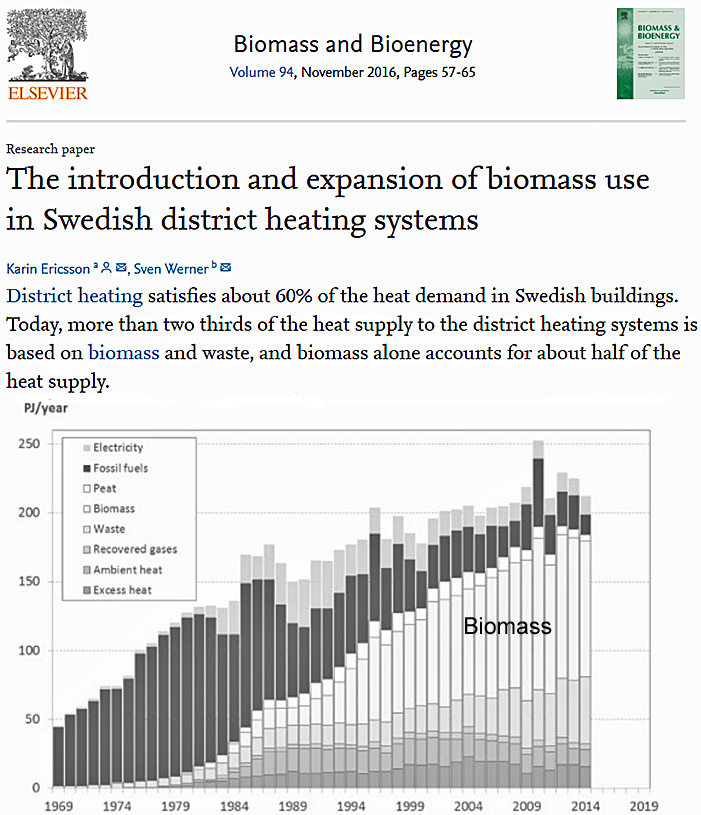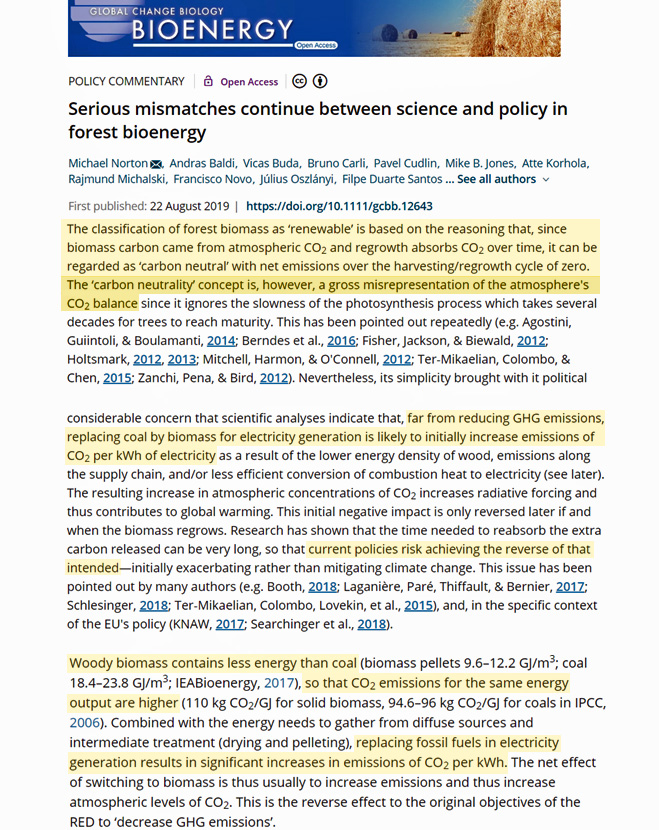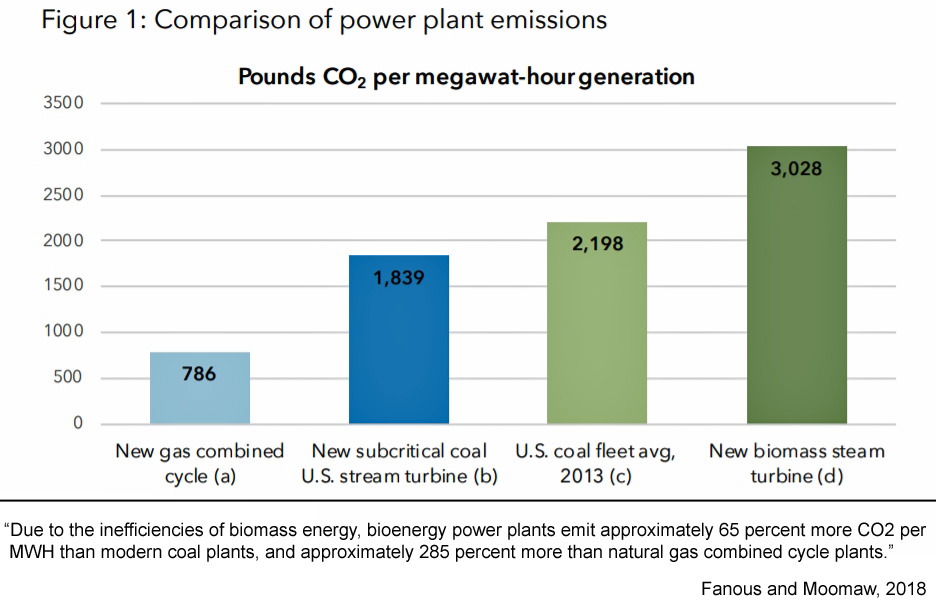A growing proportion of Sweden’s energy is derived from burning biomass (wood), which increases CO2 emissions 65% and 285% more than coal and natural gas energy generation, respectively. And yet because governmental policy – not science – has (wrongly) declared biomass burning “renewable” and “carbon neutral”, Greta Thunberg’s Sweden is falsely credited with reducing its carbon footprint.
Sweden’s CO2 mitigation advocate Greta Thunberg. Image Source: Greta’s Twitter site
In an effort to reduce its reliance on fossil fuel energy, Sweden has rapidly expanded biomass (wood) burning in recent decades (Ericsson and Werner, 2016).

Image Source: Ericsson and Werner, 2016
Biomass burning is heavily subsidized by governments in the developed world, as it is characterized as “renewable” and “carbon neutral”.
Yet scientists continue to vociferously point out that biomass burning is actually worse than coal with regard to CO2 mitigation.
The net effect of switching from coal to biomass burning is to significantly increase CO2 emissions (Norton et al., 2019, Sterman et al., 2018).

Image Source: Norton et al., 2019

Image Source: Sterman et al., 2018
Specifically, biomass burning results in 65% more CO2 emissions than coal and 285% more CO2 emissions than natural gas (Fanous and Moomaw, 2018).
Ironically, fossil fuels actually serve to reduce CO2 emissions far more than “renewable” biomass energy generation does.

Image Source: Fanous and Moomaw, 2018
Perhaps Greta Thunberg and other climate activists should listen to the scientists and focus on reducing CO2 emissions at home in Sweden before traveling abroad to stump for CO2 mitigation policies in other countries.






The harm done by biomass is not the extra CO2, that is irrelevant, but the move away from high energy-density power and what that does to the physical economy.
Now poor Greta claims to see CO2, invisible to the rest of us, I hope, but since no-one can see energy-flux-density per capita, per hectare, it is deemed not to exist.
It is exactly like just before Kepler, no one conceived of a universal physical principle, outside the prevailing geometric theories of Ptolemy,Copernicus,Brahe. That physical principle, universal gravitation, is knowable and shows the utter failure to step away from images to ideas.
Looks lie the anti-science crowd have replace universal physical principles, knowable and testable, with an invisible gas CO2.
Just a variant on the astronomers “dark matter”, a cover story.
Great comment. The all important flux-density is something which is often left out of discussions about energy. Do you read the material from the EIR pages? It’s very interesting and insightful.
Two questions” 1) Do the CO2 figures for biomass include the amount needed to harvest, transport and prepare it for use as a fuel? and 2) What about the environmental damage resulting from harvesting the biomass? Where is that data or critique?
Maybe Greta should head home and see how much of Scandinavia has move rapidly out of Autumn and to cooler climatic conditions …
https://www.aftonbladet.se/nyheter/a/b5WLmv/sno-i-varmland–tidigaste-pa-20-ar
and
https://twitter.com/mikarantane/status/1174587443162615808
Bob in NC,
A good question, as here in the Marxist enclave of Britain we have perhaps the biggest power generation plant in Europe which sits right on top of a 500 years supply of coal.
It is called Drax and is in Yorkshire. It used to supply – I dunno – several million businesses and housholds with cheap reliable power all year round.
It also provided employment for several thousand workers in the coal and sundry industries.
Some years ago the burners were converted run on wood.
The wood is harvested in the southern States – like North Carolina – is then pulped and shipped over 2000 miles to the east coast of England then transported to Yorkshire to be burned as an offering at the altar of the global warming godless Gaia.
I’m not sure what source they use for their wood-pellet biomass, but it can’t be palm trees, which grow on average a foot a year (not very renewable friendly). Could it be pine? They grow fast, and burn hot. But, if so, with all the resins in pine trees, it would be like burning plastic, with all the health “benefits” that would entail.
“I’m not sure what source they use for their wood-pellet biomass”
They’re deforesting the southern US.
https://www.vox.com/science-and-health/2019/3/4/18216045/renewable-energy-wood-pellets-biomass
Thanks, Kenneth.
Just one subheading of interest that I could have fixed for them, if I’d been allowed to.
“The wrong solution to
the righta non-problem”Lots of stuff they get wrong, except of course that cutting down forests for fuel is one reason we are fortunate to have much better alternatives. But then, it is Vox, after all.
It’s my preference to use their source material – even if it has the pro-AGW slant.
@Kenneth Richard
Yes. It is a very useful technique. I sometimes do that myself. When the “hostile witness” supports you, as it does there, it’s often more compelling than our side making the assertion.
I just thought I’d have some fun with it.
At least in NC, they use principally trees thinned from tree farms (Weyerhauser?).
When we lived in the coastal NC Morehead City area, we would see truck after truck loaded with pine trunks (Loblolly)coming to the Morehead City port where they would be unloaded in an enormous pile, then chipped and stored in an enormous mound at least 40′ to 50′ high. The chips would then be transferred onto waiting ships for shipment to the UK.
Seeing all that, I had to wonder: What is the amount of energy required for that harvest and shipment, and what is the net energy provided by the wood chips? Could nothing better be done with them?
My conclusion: Using biomass to provide “green” energy is beyond the pale ludicrous!
Oh Good!
Now I can blame Sweden for increasing CO2 levels.
Dr Tim Ball – Historical Climatologist
timothyball@shaw.ca
Book ‘The Deliberate Corruption of Climate Science’.
Book “Human Caused Global Wa rming”, ‘The Biggest Deception in History’.
https://www.youtube.com/watch?v=tPzpPXuASY8
https://www.youtube.com/watch?v=tPzpPXuASY8
https://www.youtube.com/watch?v=sO08Hhjes_0
https://www.technocracy.news/dr-tim-ball-on-climate-lies-wrapped-in-deception-smothered-with-delusion/
BREAKING – Dr. Tim Ball wins @MichaelEMann lawsuit – Mann has to pay
https://wattsupwiththat.com/2019/08/22/breaking-dr-tim-ball-wins-michaelemann-lawsuit-mann-has-to-pay/
Congratulations on winning, and being awarded court costs, etc. VERY GOOD NEWS!
Charcoal could be made from all of those trees along the eastern seaboard of the US, then shipped to England so they can have a barbecue, make something good to eat at the Drax facility. Forget electricity, who wants that?
Everybody can see carbon dioxide. Not the gas, the solid.
Greta is kind of sort of correct, a bit deceptive, but then again, still not wrong.
Not entirely honest, had she claimed she has seen UAPs, it would be more believable.
We all learn something new everyday, just too much out there in this world to possibly know everything. At this juncture in human history, we really do know a lot.
The Mississippi River bank line forest was cut and gone probably by the mid-nineteenth century. Lumber mills in Wisconsin down to Mississippi were built and deforesting was a purdy much complete by the end of the nineteenth century. Trees eventually die, might as well cut some of them, they’ll grow back.
Clams in the Mississippi were harvested and button plugs were cut from the shells in Muscatine, Iowa for many years. Crashed the world’s button market in the late nineteen hundreds. Muscatine became the button capital of the world. Buttons were a rare item prior to that time, Japan moved in on the market by mid-1930s with plastic buttons.
Monsanto has its roots in Muscatine. Interesting place to visit. If you want a bottle of ketchup, it might have been bottled in Muscatine.
Clam shells with holes in them all over every yard at the residences in Muscatine a few blocks back from the river’s edge. Mark Twain even lived there for a few years, his parents lived there. I suppose steamboats hauled buttons from there to everywhere. lol
So many clams were harvested, the harvesting was halted, laws were passed to protect the clam species, of which, one species became extinct. Button factories stopped production. Had to find a new source of income. Tomatoes and weed control were it, I guess, along with tire retreading.
Anything west of the Appalachians must have been a sight to behold before everything was mowed down and agriculture began its march across the western half of the US. A Sharps .50-caliber made life miserable for the American bison.
Sorry for the digression.
Greta needs to stick around, she has a lot to learn.
Here is a link to a chart for some of the power produced in Oregon and Washington, USA.
https://transmission.bpa.gov/business/operations/wind/baltwg.aspx
Near the bottom of the chart there are 2 lines, hard to tell apart. One is a single nuclear facility in Washington State called the Columbia Generating Station.
The other is labeled total fossil/biomass. Note that below the chart there are names, such as Columbia Ridge Landfill, Cosmopolis** Specialty Fibers, Georgia Pacific Mill, Hampton Lumber Mill, and other similar.
[**Cosmo is a dissolving wood pulp sulfite mill producing 140,000 tons annually of high-alpha pulp bales and rolls as feedstock for a wide variety of end products. Some unused heat feeds into the grid – I cannot find out how.]
Many industrial companies produce heat that can produce electricity that can feed into the grid.
Unlike DRAX (North Yorkshire) {see Patrick’s comment at 9:50} the companies in this list (not the landfills, of course) are making useful things and (and) using the excess heat to produce power.
I don’t think of this as renewable, but it does seem a good idea.
So they cut down trees which up-take CO2. Brilliant
hahaha
I agree 100%, Jl
And, in place of the trees, they raise up activist nitwits who spew screwball ideologies. Brilliant, indeed!
With any luck the CO2 they don’t remove, and which the world desperately needs, will at least partially make up for the nitwittery they increase.
[…] https://notrickszone.com/2019/09/19/sweden-gretas-home-is-rapidly-increasing-its-co2-emissions-with-… […]
[…] https://notrickszone.com/2019/09/19/sweden-gretas-home-is-rapidly-increasing-its-co2-emissions-with-… […]
[…] Sweden, Greta’s Home, Is Rapidly Increasing CO2 Emissions With Worse-Than-Coal Biomass Burning… […]
[…] spelar koldioxidens ursprung någon roll. Så vad har Sverige vunnit på denna del av klimatpolitiken? Till ganska höga kostnader har man vunnit mindre valutautflöde för importerad olja. Om vi […]